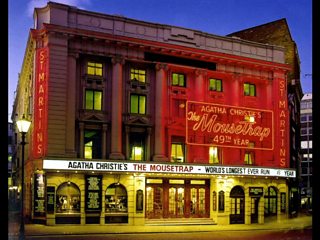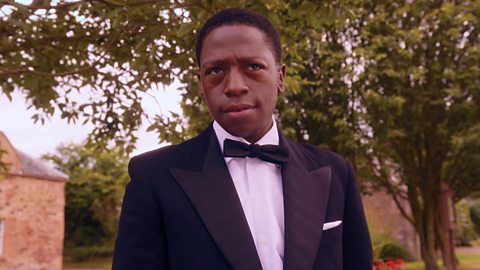Who was Agatha Christie? Here are 12 clues
The “Queen of Crime” Agatha Christie is the best-selling novelist of all time. In 66 novels, 14 short-story collections, and 20 stage plays, she depicted the evil lurking in the hearts of ordinary people.
But how did this homeschooled daughter of a privileged English family learn so much about poisons, psychopaths and murder? What in her personal life informed such a suspicious view of ordinary people? A Short History of Agatha Christie, on �鶹�� Sounds, gave us some clues.
Written by Jo Furniss, and with insights from Sophie Hannah, here are just a few of the facts we learned about the author.
If you're a fan of the “Queen of Crime”, don't miss brand new �鶹�� One adaptation of Agatha Christie’s Murder Is Easy, which starts Wednesday 27th December 2023.
1. She dabbled with writing fiction as a girl.
As a teenager, she submitted some of her short stories to magazines under a male pseudonym, which were all rejected.

2. She married a pilot of the Royal Flying Corps.
When Agatha was 22, she was introduced to Lieutenant Archibald Christie by a mutual friend at a ball at Ugbrooke House in Devon. Agatha was drawn to what she later described in her autobiography as his “crisp curly hair”, his “interesting nose”, and his “air of careless confidence”. Archie proposed in early 1913, before he relocated to continue his flying training on Salisbury plain.
3. She volunteered during the First World War.
She helped in the operating theatre at the Red Cross Hospital in Torquay, where one of her jobs was to take lost limbs to the incinerator.
4. She had a knowledge of poisons.
After qualifying as an apothecary's assistant, she learned about medicines, poisons and other dangerous substances sold by chemists. These would go on to appear frequently as murder weapons in her future writing. Of her 66 novels, 41 involved her specialist subject of poison.
5. She wrote her first published novel as a dare.
Agatha’s older sister told her to write a story with a cunning twist so cunning that it couldn’t be guessed. She came up with The Mysterious Affair at Styles, with leading man Hercule Poirot. The novel opens with the lady of the manor found murdered – by poisoning, of course. After some rejections from publishers, the book was eventually picked up by editor John Lane. It proved popular with readers.
6. The Murder of Roger Ackroyd made her name.
After writing five novels under what Agatha called an exploitative publishing contract, her sixth was snapped up by the publisher William Collins, on better terms. Roger Ackroyd is still considered to be one of Christie's best works. In 2013, it was voted one of the most influential crime novels ever written.
7. 1926 was her annus horribilis.
In April that year, Agatha’s mother Clarissa died. To recuperate from this devastating loss, she suggested to her husband Archie that they take a family holiday to the Pyrenees. In response, he informed her that he was in love with another woman called Nancy Neele – a friend of the family. Later that year, Archie was pushing for a divorce.

8. She became the subject of a real-life mystery.
On 3 December 1926, after Archie had gone to spend a weekend with friends – and presumably Nancy Neele – Agatha disappeared. The next day, Surrey police were alerted to Christie’s abandoned car. Superintendent William Kenward became convinced that the famous writer had met a tragic end somewhere nearby. But the manhunt went on for 10 more days, and became a sensational front page news story. Finally, Agatha was identified on 14 December in the Hydropathic Hotel in Harrogate – checked in under the name Mrs “Neele”.
9. Book sales made her rich.
In the aftermath of her disappearance and divorce, Agatha continued to write a book a year, each selling more copies than the last. By the 1950s, Christie was earning around £100,000 a year – about £2.5 million in today's money.
10. She liked archaeology.
On a whim in 1928, she travelled to Baghdad on the Orient Express train. While in the desert, she helped out on archaeological digs by sketching and cataloguing artefacts. She met an archaeologist called Max Mallowan, 14 years her junior, who she went on to marry in London in 1930.
11. She volunteered during the Second World War.
This time, Christie stayed in London to help in hospitals during the Blitz. Given the dangers, she wrote two books designed to be the final appearances of her characters Poirot and Miss Marple. She put these novels into storage, in case she were to lose her life.
12. She wrote the longest running production in the West End.
It was in the 1950s that Christie became a prominent playwright. Her play The Mousetrap opened on the 25th November 1952 in the West End, where it has run for over 70 years – interrupted only by theatre closures during the Covid pandemic.
Brand new �鶹�� One adaptation of Agatha Christie’s Murder is Easy starts Wednesday 27th December 2023. Watch the trailer below.

Trailer: Murder Is Easy
Luke Fitzwilliam unexpectedly finds himself investigating a series of suspicious deaths.
More from the �鶹��
-
![]()
Revisionist History
Malcolm Gladwell's journey through the overlooked and the misunderstood.
-
![]()
Shedunnit
Unravelling the mysteries behind classic detective stories.
-
![]()
Murder They Wrote with Laura Whitmore and Iain Stirling
Laura Whitmore and Iain Stirling dive into some of the world's most jaw-dropping crime stories.
-
![]()
Bad Women
Historian Hallie Rubenhold tells the real, untold story of the Jack the Ripper victims.





